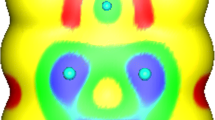Abstract.
Regional density functional theory has been extended to treat irreversible thermodynamic electronic processes for application to adiabatic electron-transfer processes of chemical reactions. Onsager's local equilibrium hypothesis is slightly modified to take into account the quantum mechanical nature of the electron. The quantum mechanical interference effect has been demonstrated to be included in the entropy production rate formula associated with electron transfer through an interface. A new formula for the determination of the transition state of a chemical reaction has been postulated that corresponds to the maximum of the regional electron transferability. A quantum mechanical law of mass action has been established and applied to prove the regional electrochemical potential inequality principle.
Similar content being viewed by others
Author information
Authors and Affiliations
Additional information
Received: 1 July 1998 / Accepted: 2 September 1998 / Published online: 8 February 1999
Rights and permissions
About this article
Cite this article
Tachibana, A. Chemical potential inequality principle. Theor Chem Acc 102, 188–195 (1999). https://doi.org/10.1007/s002140050490
Issue Date:
DOI: https://doi.org/10.1007/s002140050490




